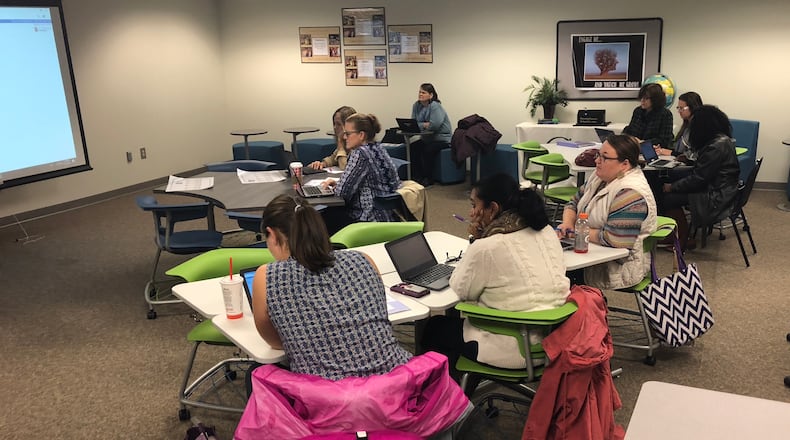A chair brought calm to one of Michelle Clarke's math students in Coweta County's Madras Middle School.
The seat, called the Ruckus Chair, was slightly taller than normal classroom chairs, made of painted gray metal with a green back made of reinforced fiberglass polypropylene shaped like a boomerang. The "nondirectional" seating design allowed the student to sit facing front or back, and to move within his personal space without disrupting others.
“It allowed (the student) to get rid of excess energy,” said Clarke, who recently took a job as the district’s math content specialist.
Clarke's classroom was renovated and redesigned halfway through the last school year through the Ruckus Grant Program, which sought to find the direct impacts of furniture on teaching and learning. The new furniture replaced traditional classroom desks and Clarke said it forged a path of unconventional thinking when it came to creating the educational environment.
She’s taken what she learned to a larger audience, assembling the furniture in a training room on the second floor of the Coweta County Schools headquarters in Newnan.
“It has opened their eyes, got them thinking out of the box,” Clarke said of other teachers. “They’re finding the more comfortable the kids are, the more apt they are to stay engaged.”
School districts are testing the waters in various areas to find what works to help them better educate students, from dual-immersion programs to restorative-justice practices and complete curriculum overhauls. The flexibility the furniture used in Clarke's classroom adds — among the items were tables of varying heights, chairs with wheels, backless stools — could help students be more comfortable, work closer and even expend excess energy.
Little research seems to zero in on the impact of furniture in the learning environment. A study published in 2017 on the influence of school furniture on student performance, however, found that 64 percent of participants presented positive results, based mostly on the direct compatibility of a subject's body shape with furniture design and size.
Bryan Ballegeer, vice president of education markets for manufacturer KI Furniture, said the company wanted to see whether furniture alone could improve student outcomes, hence its award of the Ruckus Grant.
“All the research … has all focused around changing everything. Not just furniture, but the wall color, the lighting, the way a teacher teaches,” said Ballegeer, a former school administrator in New York City. “At KI, we make furniture. We’re not educators.
“I can’t teach a teacher to teach a different way.”
The company selected nine schools — of varying grade levels through college, and spread from low-income to more affluent — from about 200 schools that applied. Many students spent the first half of the year with their normal classroom furniture. After the winter break around Christmas, students came back to classrooms that had been outfitted with the new furniture. For college students, the transformation took place over spring break, as the experiment only lasted a semester for them.
The furniture was a hit, he said. And student surveys conducted by the teachers showed huge increases in learning. Learning retention was up 32 percent, as was participation and engagement.
The biggest improvements came in elementary school classrooms, Ballegeer said.
“Why? General curiosity and excitement of younger kids,” he said. “Having new furniture is probably going to excite a 9-year-old more than a 20-year-old. That curiosity (younger students) have, part of why we did this is our Ruckus Chair is a pretty innovative chair. We believe it’s really shifted paradigm of what a chair can and should do.”
Clarke said she also saw a significant dip in disciplinary actions from her middle-school classroom. The furniture's movability contributed greatly, giving students an outlet to waste energy without being disruptive.
“Some students just needed to work out that excess energy,” she said. “Now, they’re not disturbing others around them when they do it.”
She said while other teachers have reached out to get contact information to order new furniture, some have taken it upon themselves to make other tweaks to their classrooms. She walked into one recently that used bean bag chairs and other nontraditional items to give the students options, and more opportunity to move around.
“It’s just the idea that we don’t have to stick to what we have,” she said. “If it made a difference in one student, that was enough.”
About the Author
Keep Reading
The Latest
Featured

